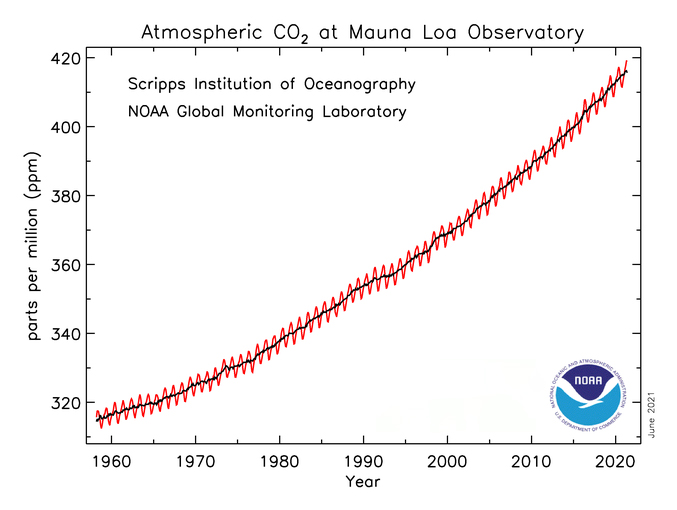A barely colder than normal May has been followed by an extremely warm and dry first two weeks of June.
Through Friday June 11th, Madison had five days with high temperatures above 90 degrees, and the month has thus far averaged more than 11 degrees above normal.
Simultaneously, the dry spring has continued into the early summer with the month of June already 1.69 inches of rain below normal, and that’s after April and May came in at a combined 4.24 inches below normal.
Coincidentally, this week the National Oceanic and Atmospheric Administration (NOAA) reported that the monthly average carbon dioxide (CO2) fraction in the atmosphere, as measured at the top of Mauna Loa in Hawaii, set a new record of 418.92 ppm (parts per million) in May.

Credit: NOAA Global Monitoring Laboratory
This represents a larger than 50% increase in atmospheric CO2 concentration since the pre-industrial age (1750-1800), when the value was about 280 ppm as measured by analysis of air bubbles in ice cores taken from ice sheets in Antarctica and Greenland. The current value has not been observed on Earth in the last 4.1 million to 4.5 million years, when sea levels were 78 feet higher than they are today and the global average temperature was 7 degrees warmer than at present.
Not even the COVID-19 pandemic was able to put a dent in the rate of increase in CO2, which suggests that, unless we change the nature of our energy use, we are continuing to forge a path toward a very different, and likely extremely adverse, climate future.
Since solar and wind energies are already cheaper than fossil fuels and they work at the scales necessary to power the world, there is no reasonable excuse for not moving aggressively to a more sustainable energy future.
Steve Ackerman and Jonathan Martin, professors in the UW-Madison department of atmospheric and oceanic sciences, are guests on WHA radio (970 AM) at 11:45 a.m. the last Monday of each month.

